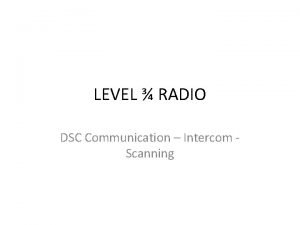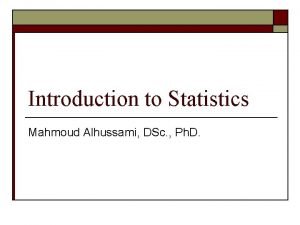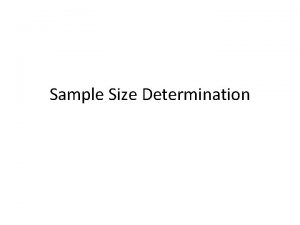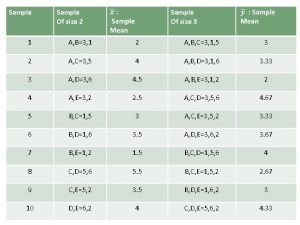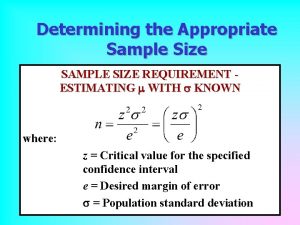Sample Size Mahmoud Alhussami DSc Ph D Sample
















- Slides: 16

Sample Size Mahmoud Alhussami, DSc. , Ph. D

Sample Size Determination l Is the act of choosing the number of observations or replicates to include in a statistical sample. l The sample size is an important feature of any empirical study in which the goal is to make inferences about a population from a sample.

Sample Size How large should a sample Be? l Factors to be considered in deciding the size of the sample: Homogeneity of the population l The degree of precision desired by the researcher l The type of sampling procedure that will be used l

Sample Size l Large sample sizes may be needed in the following instances: l l l Many uncontrolled variables are present. i. e. , inability to control for age Small differences are expected in members of the population on the variable of interest The population must be divided into subgroups Dropout rate among subjects is expected to be high Statistical test are used that require minimum sample sizes.

Sampling Error and Sampling Bias: l Sampling error: the difference between data obtained from a random sample and the data obtained that would be obtained if an entire population were measured. l Error is not under the researcher’s control and caused by chance

l Sampling bias: is the bias that is caused by the researcher when the samples are not carefully selected (not a matter of chance) l Example: selection from the telephone directory but this record has some people missing form the register for some reasons

Sample Size l Before using the sample size calculator, there are two terms that you need to know: l l Confidence Interval Confidence Level Confidence interval (also called margin of error) is the plus-or-minus figure usually reported. E. G. 10, 20, 30. l The Confidence level tells you how sure you can be. It is expressed as a percentage and represents how often the true percentage of the population who would pick an answer lies within the confidence interval. E. G. 95%, 99% l

Example If you asked a sample of 1000 people in a city which brand of cola they preferred, and 60% said Brand A, you can be very certain that between 40 and 80% of all the people in the city actually do prefer that brand, but you cannot be so sure that between 59 and 61% of the people in the city prefer the brand. l The wider the confidence interval you are willing to accept, the more certain you can be that the whole population answers would be within that range. l

Factors that Affect Confidence Intervals Sample size: The larger your sample size, the more sure you can be that their answers truly reflect the population. This indicates that for a given confidence level, the larger your sample size, the smaller your confidence interval. l Percentage: Your accuracy also depends on the percentage of your sample that picks a particular answer. If 99% of your sample said "Yes" and 1% said "No, " the chances of error are remote, irrespective of sample size. However, if the percentages are 51% and 49% the chances of error are much greater. l Population size l

Sample Size Too Big: • Requires too much resources Too Small: • Won’t do the job

Estimation Process Population Mean, , is unknown Sample Random Sample Mean X = 50 I am 95% confident that is between 40 & 60.

Methods of Sample Size Determinattion l Estimation of means. l Estimation of Proportions. l Power Tables for Effect Size l Power of a Statistical Test (G* power)

Example: Sample Size for Mean l. What sample size is needed to be 90% confident of being correct within ± 5? A pilot study suggested that the standard deviation is 45. 2 n Z 2 Error 2 1645. 5 2 2 45 2 219. 2 220 Round Up

Example: Sample Size for Proportion l. What sample size is needed to be within ± 5 with 90% confidence? Out of a population of 1, 000, we randomly selected 100 of which 30 were defective. 228 Round Up

Power Tables for Effect Size d (from Cohen 1988, pg. 55). Cohen's d is defined as the difference between two means divided by a standard deviation for the data. l Power Tables for Effect Size r (from Cohen 1988, pg. 102). is a statistical concept that measures the strength of the relationship between two variables on a numeric scale. l Power_Tables. pdf l

Power of a Statistical Test l G* power (GPOWER) l The result of using computer program G* power (Faul et al. , 2007) showed that the required sample size was 146 participants. This figure was arrived at by using compromised β=0. 80, α = 0. 05 (2 tailed) and medium effect size.














